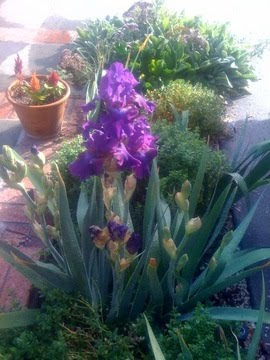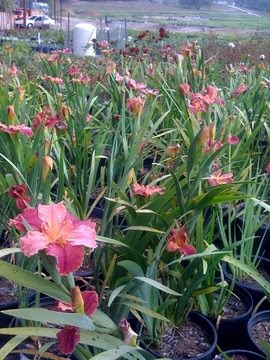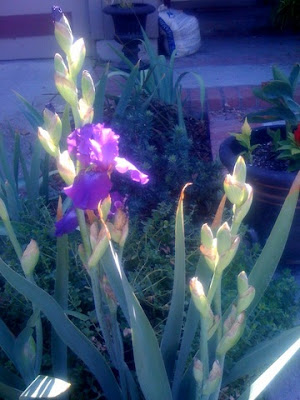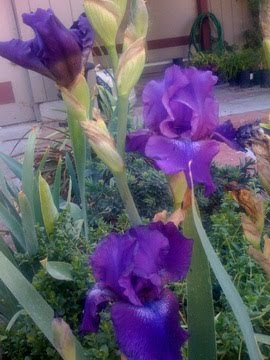There are many types of Iris that are cultivated in the United States. Since I work in Southern California and buy all my Iris plants from one vendor, Greenwood Day Lily Gardens, I will only touch lightly on varieties that I cannot get, or will not work in my area.
Spanish, Dutch or English Iris plants are bulbs grown mainly for cut flowers. Florists and plant growers use these types of Irises for flower arrangements; mostly they are not used in a garden setting.
Iris ensata or Japanese Iris, come in white, blue and pink – they love water and are fairly tall plants. They don’t grow well in Southern California however areas without alkaline water or soil will find that they thrive. They look beautiful around ponds and other water features. In our area Louisiana Irises are a great substitute and of course Greenwood has them!
Siberian Iris plants also do not do well in Southern California for some of the same reasons as the Japanese Iris, so we can substitute the Louisiana or Spuria. You lucky mid-west and easterner gardeners can enjoy the Siberians for us.
Spuria Iris are tall perennial irises they range from about 3’ – 6’ and have striking blooms on erect dark green foliage. They look a lot like giant Dutch Iris and they make wonderful cut flower. They pop up year after year with their beautiful white or yellow flower and are often mistakenly referred to as Japanese Iris. They are nothing like the Japanese Iris in one specific trait, they are drought and heat tolerant and prefer heavy, rich soil and like to have their roots in the shade (you can just mulch them). They need at least a half-day of full sun to bloom properly. After the iris blooms you can either continue watering for beautiful foliage or with hold water to let the plant go dormant. Hint: hot weather areas option two is easiest. When the foliage starts looking brown, cut them back to 8-9” and start watering again when the new foliage begins emerging. Spuria Iris do not like to be messed with, so they should only be divided every five to ten years.
Iris japonica ‘Nada’ or Iris ‘Nada’ I found this Iris on the recommendation of John Schoustra owner of Greenwood Day Lily Gardens while in search of plants to use under three huge Pine Trees – I fell in love with this wonderful plant! It is the perfect drought tolerant shade iris for Southern California. The Iris has ruffled white blooms with a touch of lavender, on stems 18”-24” tall over broad bright green foliage up to 18” tall.
I have it mixed in with Ferns, Geranium x Maderense, Hydrangeas, Gardenias, Plectranthus and other hardy acid loving plants. John says that it works great with Clivias and Camellias too!
Louisiana Iris are a great substitute for Japanese or Siberian Iris, they can tolerate poor draining soil and like a little shade. They are perfect near a pond or water feature. They have beautiful green foliage, and I have seen three colorful varieties that I just love!
Pacific Coast Native Iris plants are early bloomers starting their show in April. They are native to California, Washington and Oregon and although they are pretty easy to grow in Northern California they can be a little bit of challenge here in Southern California, especially in the area that I live in. If you use them please be sure not to plant them near anything that will reflect heat, for example against one of our many block walls or in the middle of a parking lot. John suggests using Grandma’s Purple Flag or Great Grandma’s Purple Flag as a substitute. Or… if you are planting in dry shade why not try one of the Iris ‘Nada’ plants?
Bearded Iris are probably the showiest of the bunch, they also are the most fragrant. One of my other plant vendors (Sara) says that they smell like whatever color they are, and if you take a good sniff of two different color iris you will see that she is right! Sara’s family owns Worldwide Exotics and they too have great Iris – just not as many as Greenwood. When Bearded Iris are used in Southern California, they are much more drought and heat tolerant than our native Cali Irises (sorry) and up until recently their use in landscape has been a little bit limited due mostly to their short bloom season. John at Greenwood has varieties of Iris that rebloom, up to five times a year! If you pick your Irises correctly and live in California you can enjoy Irises most of the year. Bearded iris have the most variety among them, they can be as small as 8” to as tall as over 26”.
This is Javier from Greenwood Day Lily Gardens owned by John Schoustra
Since most of the smaller bearded Iris varieties need a substantial winter chill to bloom well, Southern California gardeners will do best with the tall bearded varieties. The older varieties with less ruffled standards are referred to as “Van Gogh style” blooms.
Bearded iris blooms have six petals: three that stand up (standards) and three that hang down (falls). Each fall has a small fuzzy spot near the throat (the beard). Older iris varieties, with narrower, less ruffled standards than newer tall bearded, are referred to as “Van Gogh style” blooms. Peak iris bloom here is late April-May.
If the Iris are planted in August or September, they will very likely bloom the following spring. If they are planted at a later time in the fall, they will concentrate growth on their foliage during the first year and they will flower in the fall. Last year I replanted a bunch of Irises the second week of November and those Irises just started blooming for Labor Day!
Care for Tall bearded Iris is fairly straight forward bearded Iris prefers average garden conditions, with at least half a day of full sun. These plants do not thrive in soggy areas, shady areas (foliage yes, bloom no) or with poor air circulation. You should be sure to cover the rhizomes with ¼” to ½” of soil, and you should avoid using herbaceous ground covers and heavy mulch. Since Tall bearded Irises are not finicky the can survive with low soil fertility, drought yet thrive in a mixed bed of roses and day lily plants. To keep the Iris blooming for may years, you should dig and divide them every 2-4 years. If you forget when you last divided them, you will notice that you have fewer and fewer blooms, so don’t trash them… divide them! (See notes below) Fertilizing is not essential however a low nitrogen fertilizer applied in February and a nice top dressing of compost and gypsum in January/February and August/September will fill their fertilizing needs.
Planting your new Iris rhizome. Dig a shallow hole big enough to hold your rhizome. Form a mound in the center of the hole and set the rhizome on top and let the roots drape down into the hole. Cover the rhizome so that about ¼ – ½” of soil is over the rhizome. Point the fan of leaves in the direction you want it to grow. Water the plant thoroughly and make sure that the Iris settles in. I like to plant clumps of three Irises near one another. This adds unity to your planter bed.
After your Iris blossoms fade you can cut the stalk down to the leaves. The fans of leaves should be left on the plant until late fall because they are making food for the rhizome. The rhizome will be creating offset, which is the manner in which the Iris reproduces. You can also remove the old dried leaves from the plant – especially in the fall. In the late fall you will want to cut back the leaves to about 5” tall.
Dividing your Iris – you will be dividing the Iris to help stimulate new blooms, to manage the amount of space the Iris are taking up, and to have more Iris plants. The best time to divide is about 6 weeks after the blooming ends. If possible withhold water for about a week prior to dividing. (If they are in a bed with other plants… that may not be possible.)
Using a sharp shovel or spade dig around (and under) the entire clump and pry the plant free. Remove the old soil. Cut the leaves to about 6” and trim the long feeder roots back by 1/3. Using a sharp knife cut off divisions. Make sure each division has a fan of leaves and some nice strong roots. Anything mushy, moldy or blackened should be discarded. Leave the divisions out for a day, let the cut ends heal but keep the roots moist. The next day, plant the cleaned rhizomes in the same manner as listed above. You will probably have more rhizomes than room to plant, so select the best rhizomes and discard the rest, or share with friends, family, and neighbors. We have kept varieties of Iris in our family for three generations. Blooming for years in Grandma’s garden, then Mom’s garden, then in our family gardens.
Over the years tall bearded Iris have been relegated to a corner of the garden. Iris aficionados have grown them following a rigid set of rules and have avoided using companion plants. With the discovery of Greenwood Nursery’s rebloomers Irises can share the stage with a variety of other plants to create a lot of impact in your garden. Here are a few ways that you can use Iris in the garden that have been over looked over the years.
Use Tall Bearded Iris in front of tea roses. They can hide the ugly bottom canes of the pruned roses with beautiful foliage and flowers. You can even mix them in with other types of roses that don’t need them to cover up their not so beautiful attributes.
Tall Bearded Iris look great as a back drop for furniture, rocks, and other hardscape features. Even when they are not in bloom their wonderful foliage makes a dramatic statement.
Add Bearded Irises to your Mediterranean garden palette. They can acclimate to the same water and sun requirements as lavender, rosemary and citrus.
Try some Bearded Irises in with your succulents, the foliage is a nice complement to the succulents and the blooms really add a punch to your xeriscape.
Bearded Irises can be planted with penstemons, salvias, and California poppies – go “native” with them. They will fit in well with both a native garden and along a dry creek bed. I love to tuck them in around rock groupings, they look great with and with out flowers popping from between the “crags”.
Create a French Cottage look, placing Iris, Day Lily and Limonium in front of some beautiful climbing roses. In front of a wall or on a trellis they will be sure to capture the eye of all those wandering through your garden.
You can visit Greenwood on the web at: Greenwood Day Lily Gardens
For more information see my website www.thegrassisalwaysgreener.net


















